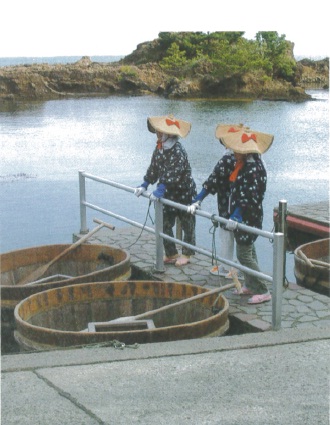by Hillel Wright
The Ogi Peninsula on Sado Island has no trains or subways, no McDonald’s, no Starbucks, and no convenience stores. The best news is that you can escape from Tokyo to this alternative world in just five hours.
GETTING THERE
The best strategy for your otherworldly adventure is to wake up early. Catch the Joetsu Shinkansen around 7am and change to the Hakutaka express at Echigo Yuzawa, for Naoetsu. You’ll arrive at Naoetsu station around 9:15am, leaving ample time to catch the 9:50am sailing of the Sado Kisen ferry (¥2060), about a ten-minute taxi ride from the station. The ferry, which crosses the Japan Sea to Sado, arrives at Ogi Port just after noon.
Buses run from in front of Ogi Port, but only about once every two to three hours, from about 7am-5pm. You can get a schedule (Japanese only) at the information booth just outside the Port terminal.
WHERE TO STAY
I highly recommend the Hananoki B&B in Shukunegi Shinden, about a 15-minute bus ride from Ogi Port terminal. Besides breakfast, the inn also serves an absolutely unbelievable Japanese-style seafood dinner (optional — reservations must be made a day in advance) for about ¥6,500 which features whole crab, locally caught sazae (turban snail) and tuna and abalone sashimi, seasonal yakiza-kana or grilled whole fish — I had mebaru — as well as unique and locally produced seaweed salads, and the famous and delicious Sado Island koshihikari rice.
The rooms, some in the main building, an old Japanese farmhouse, some in detached units, are comfortable and convenient — air con, private bath, and toilet — with a decidedly rural flavor… shoji, tatami mats, and futon. The only sounds you hear at night are frogs and cicadas. Prices start from only ¥5,600 for a single.
The inn is at the foot of a landmark promontory with rice fields in front, and is in easy walking distance to the main attractions. Closest is the Iwayasan Cave, where local women traditionally (and still do) gather to chant, and just a few minutes on, the Sadokoku Ogi Folk Museum which houses the 25 meter Hakusan Maru, a re-creation of an Edo Era trading vessel, and displays of traditional boat-building tools, small boats and fishing gear.
Down the hill from the museum is Shukunegi Village, an authentic island fishing village preserved to ‘living museum’ standards by government funding, with narrow, winding streets and large wooden houses squeezed chock-a-block together. This is Japan as it looked hundreds of years ago.
Just across the little-used road, which winds along the Ogi Coast Natural Monument from Ogi Port to Sawasaki Lighthouse, is Shukunegi fishing harbor, a good place to swim and/or camp. There is also a cave at the end of the beach where the fishing boats are kept, which is open at both ends and will take you to a hidden cove with a lovely little black sand beach. This spot is truly off the beaten path.
WHAT ELSE TO DO
From the tourist industry’s point-of-view, Ogi Hanto’s main attraction is the taraibune, round or slightly oval tub boats, which look like a barrel cut in half and are propelled by sculling with an ingenious paddle by colorfully clad fisherwomen around the harbor at Ogi Port. But within walking distance of Shukunegi Shinden is Yajima Kyojima, a tiny, picturesque harbor with a trio of taraibune women ready to take you out on a much more relaxed and photogenic glide (¥500/ ten minutes).
Back in Ogi Town, you can visit Ogi’s natural saltwater hot spring at the Kamomeso B&B, about a 15-minute walk from the Port. Day use of the onsen is available, but if you have time to stay the night, you can rent a room for about ¥6,500, Japanese style breakfast with 24-hour use of the onsen baths (inside & out) included.
WHAT TO EAT
Besides Ogi Town, Shukunegi Village offers the only restaurants on the peninsula. Soba, as well as seafood, is a local specialty and there is a small soba restaurant open for lunch in the village car park, across from the post office. The Nanohana, inside the village itself, offers fine seafood cuisine for dinner.
There are several soba and seafood restaurants in Ogi Town and around the port, but I also suggest trying the Oasiss (yes, three s’s) Restaurant, right across the road from the Kamomeso. Owned by transplanted New Yorker Marc Desoto and his wife Kaoru, the Oasiss features a creative and delicious wayo-sechu mix of Japanese touches to New York staples like pasta, pizza and sandwiches. The coffee is also good and just ¥280 for a western-sized cupful. Kaoru, who was living in New York when she met Marc, bakes a variety of wholesome and whole grain breads featured in the sandwiches.
I tried the seafood pizza — eight slices for ¥800 — topped with local specialties ika, tako, hotate, awabi and jako (squid, octopus, scallop, abalone, krill). As a pizza lover generally dismayed by the state of pizza in Japan, I was more than impressed and satisfied.
GETTING HOME
Ferries to and from Ogi vary with the seasons. Check the Sado Kisen timetable available in English, www.mijintl.com. The food options on the ferry are limited, so it’s probably wise to plan ahead. When the weather is good, there’s plenty of room for picnicking on deck.








